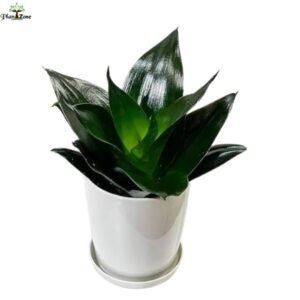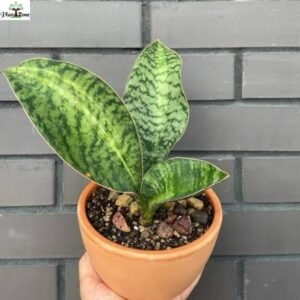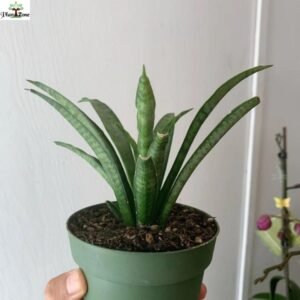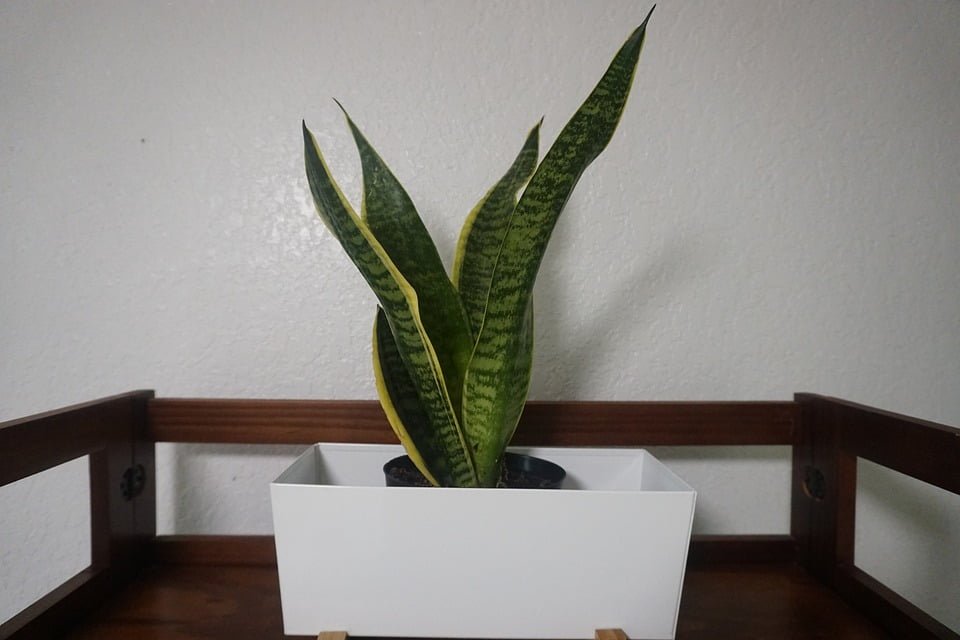
The Snake Plant is also popular as Sansevieria. It is famous for its striking look and toughness. Native to West Africa, this plant has tall and upright leaves that can reach 3 feet in height. The leaves often have green and yellow patterns, adding beauty to any space.
Snake plants are great for purifying the air. They remove indoor toxins like formaldehyde and benzene. Additionally, they release oxygen at night, making them ideal for bedrooms.
These plants are easy to care for, thriving in low to bright indirect light. They need less light, so they are perfect for beginners or busy people. With their unique presence and health benefits, these plants improve decor & air quality.
Major Varieties of Snake Plant
The snake plants come in various varieties including a range of shapes, sizes, and colors. Some of the most popular varieties include:
Sansevieria ‘Black Dragon’
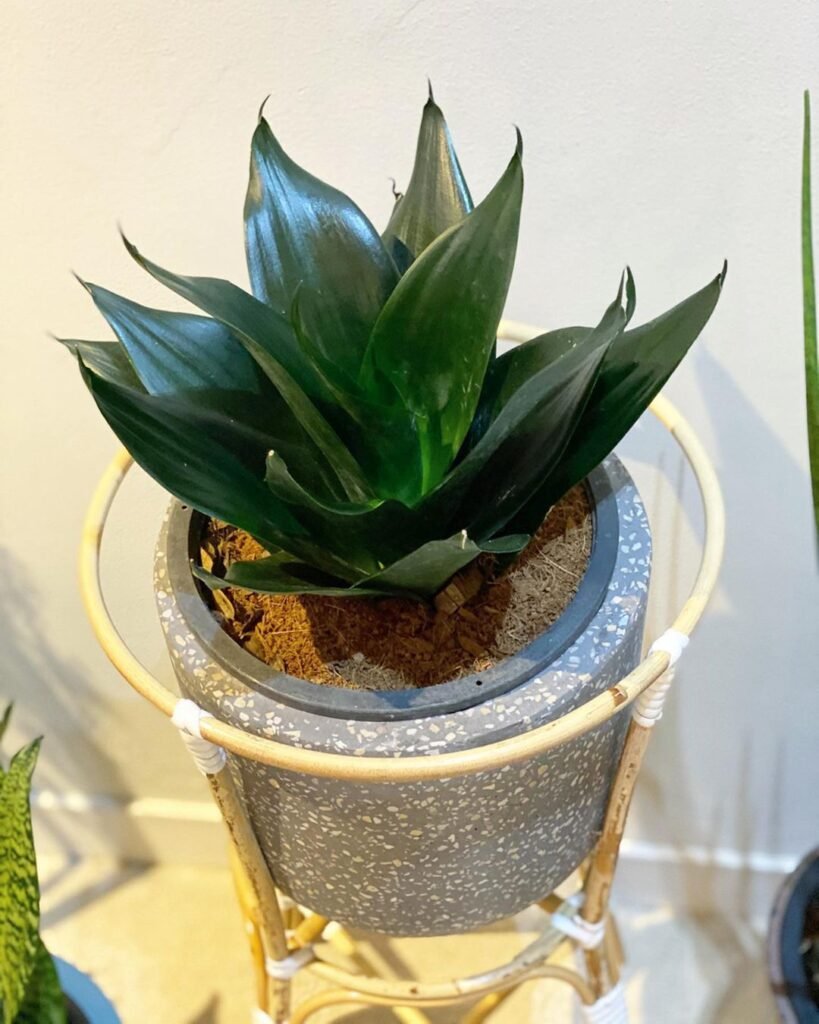
Sansevieria ‘Black Dragon’ is a main variety with glossy dark green to black leaves. This plant grows only 3 to 5 inches tall, making it great for small spaces. Its upright, sword-like leaves add a bold look to modern decor. Black Dragon is easy to maintain, needing indirect light and little water. Like other snake plants, it also purifies indoor air.
Sansevieria Bird’s Nest Snake Plant
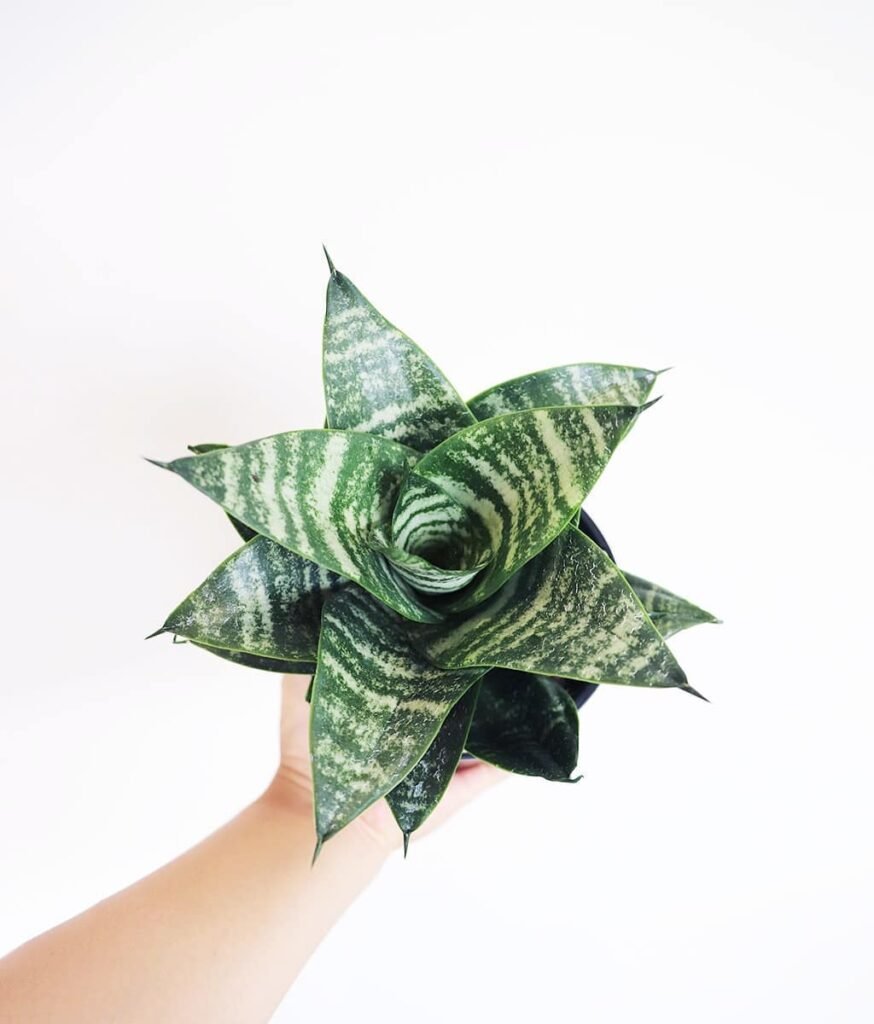
The Bird’s Nest Snake Plant grows in a rosette shape that looks like a bird’s nest. Its leaves are short and thick, and often feature green and yellow patterns. This slow-growing plant reaches about 12-18 inches tall. It’s perfect for tabletops or small spaces. Bird’s Nest thrives in indirect light and only needs occasional watering. It also helps clean indoor air.
Sansevieria Coppertone
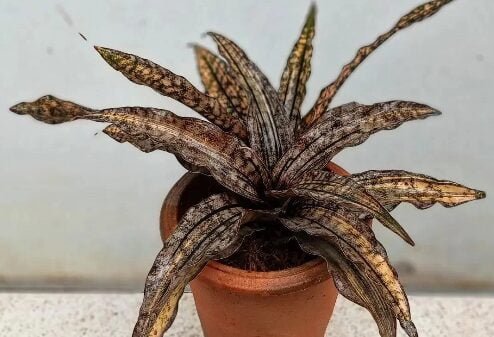
Sansevieria Coppertone is popular for its striking copper-orange leaves. This plant grows to about 12-18 inches tall, with upright, sword-like leaves. It thrives in bright, indirect light but can also adapt to lower light. Coppertone requires little water and improves air quality by filtering toxins.
Sansevieria Dracaena Masoniana (Whale Fin Snake Plant)
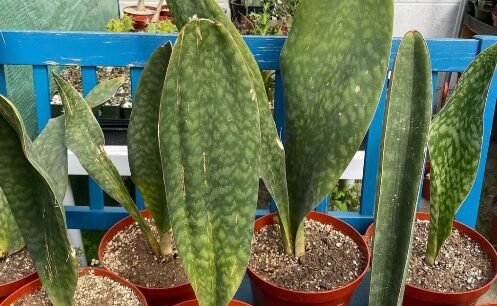
The Whale Fin Snake Plant stands out with its large, paddle-shaped leaves, growing up to 3 feet tall. The leaves are dark green with unique patterns, resembling a whale’s fin. This plant thrives in indirect light and needs minimal watering. Its air-purifying properties make it a perfect indoor plant for beginners.
Sansevieria Francisii

Sansevieria francisii features slender, upright leaves that grow in a rosette shape. The leaves are dark green with lighter stripes, adding contrast. This plant grows 12-18 inches tall and thrives in indirect light. It’s drought-tolerant and requires little care, making it a great fit for busy people.
Sansevieria Golden Hahnii Snake Plant
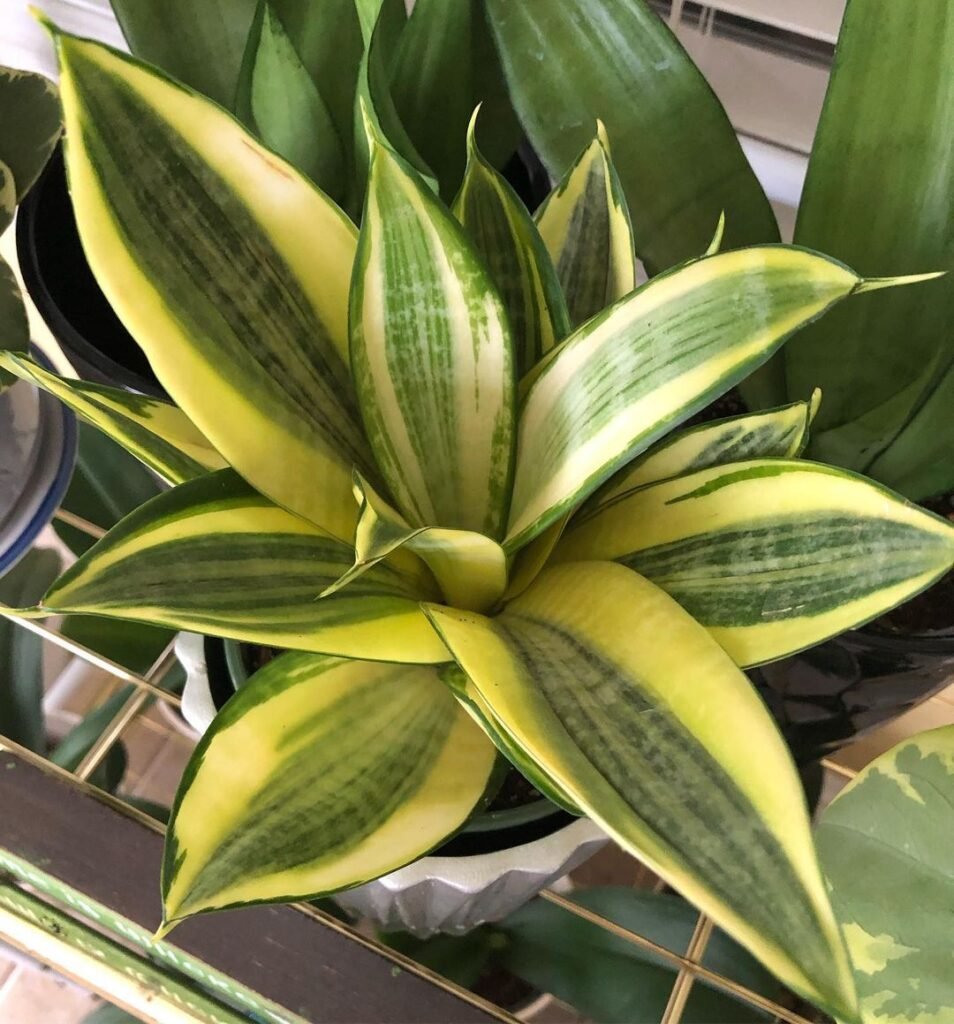
Sansevieria Golden Hahnii is a dwarf variety with yellow-edged leaves. It grows 6-12 inches tall, making it perfect for small spaces. This plant thrives in indirect light but can adapt to lower light. Golden Hahnii is drought-tolerant and requires little water. Like other snake plants, it purifies indoor air.
Sansevieria Hahnii ‘Silver Streaker’

Silver Streaker has silver-green leaves with dark green stripes. It grows to about 6-12 inches and features a rosette shape. This plant thrives in indirect light and is drought-tolerant. It’s also known for purifying air and adding style to home decor.
Sansevieria Lilliput Indoor Plant
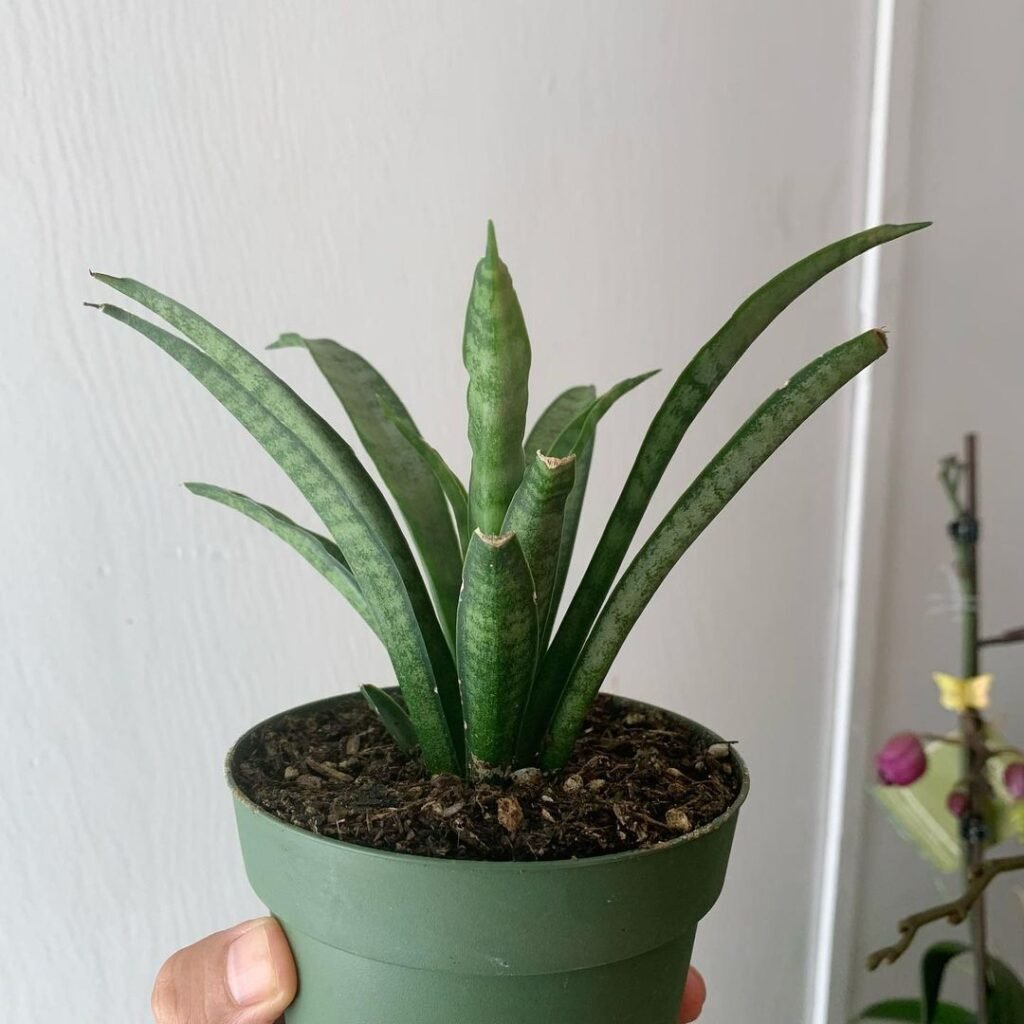
Sansevieria Lilliput is a dwarf variety with short, thick leaves. It grows to about 6-8 inches, forming a dense rosette. The leaves are dark green with subtle stripes, providing a nice contrast. Lilliput thrives in indirect light and needs little water. It also improves indoor air quality.
Sansevieria Moonshine Snake Plant
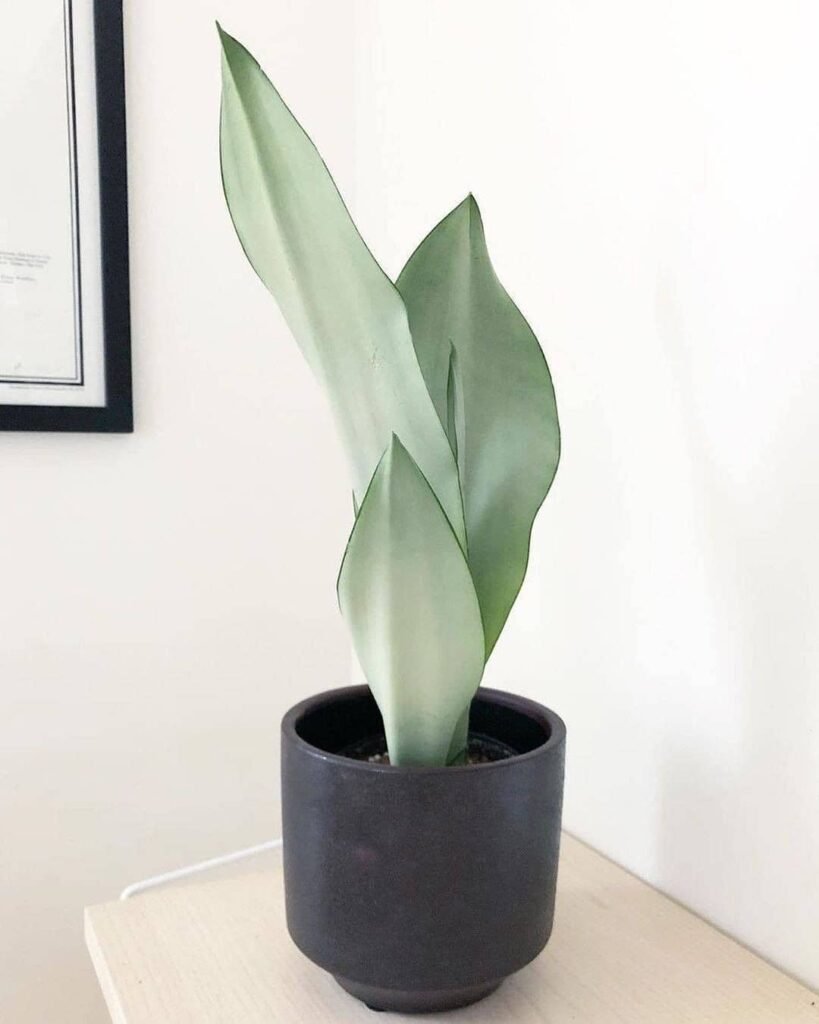
Sansevieria Moonshine has silvery-green leaves that appear to glow. This plant grows 2-3 feet tall, with upright, sword-like leaves. It thrives in bright, indirect light but tolerates lower light. Moonshine is drought-tolerant and easy to care for. It also purifies air, improving the indoor environment.
Snake Plant Care Guide
If you want to take care of your snake plant, you must take care of the following things:
- Light Requirements: Snake plants grow best in bright and indirect sunlight. Avoid direct sunlight as it can burn the leaves.
- Watering: Allow the soil to dry completely between waterings, usually every 2 to 6 weeks. Overwatering can cause root rot.
- Soil: Use a well-draining potting mix, like a cactus blend. Avoid moisture-retaining soil to prevent root rot. Ensure the pot has drainage holes.
- Temperature and Humidity: Snake plants prefer temperatures between 70°F and 90°F (21°C to 32°C). They can tolerate temperatures as low as 50°F (10°C).
- Fertilization: Feed the plant with diluted fertilizer during the growing season. Avoid fertilizing in winter.
- Pruning and Maintenance: Prune yellow or damaged leaves at the base to keep the plant healthy.
- Repotting: Snake plants like being root-bound, so repot every 2 to 3 years. Use a larger pot with fresh, well-draining soil.
- Pest Control: Snake plants are resistant to pests but may attract mealybugs. Use insecticidal soap or neem oil to treat infestations.
How to Grow Snake Plants? Follow the Given Steps
Enjoy the beauty and air-purifying benefits of your snake plant for years to come. Follow these simple steps to grow the snake plants:
Step 1: Choose the Right Variety
Select a snake plant variety that suits your space and preferences. Some popular options include Sansevieria trifasciata ‘Laurentii’ with yellow-edged leaves, Sansevieria cylindrica with cylindrical leaves, and Sansevieria ‘Moonshine’ with silvery-green foliage.
Step 2: Provide Proper Lighting
Snake plants thrive in bright, indirect sunlight but can tolerate low-light conditions. Place them near a window that receives 8-10 hours of sunlight daily. Avoid direct sun, which can scorch the leaves.
Step 3: Watering
Allow the soil to dry out completely between waterings. Water every 2-6 weeks, depending on the season and humidity levels. Reduce watering in winter when growth slows down.
Step 4: Use Well-Draining Soil
Use a well-draining potting mix, such as a cactus or succulent blend. Ensure the pot has drainage holes to prevent waterlogging.
Step 5: Fertilizing
Feed your snake plant with a balanced diluted fertilizer once every 2-3 months. Avoid fertilizing in winter.
Step 6: Prune and Maintain
Prune any yellow or damaged leaves to maintain the plant’s appearance. Use clean, sharp scissors to cut leaves at their base. Dust the leaves to keep them clean and healthy.
Snake Plant Benefits: From Air Purification to Mental Health
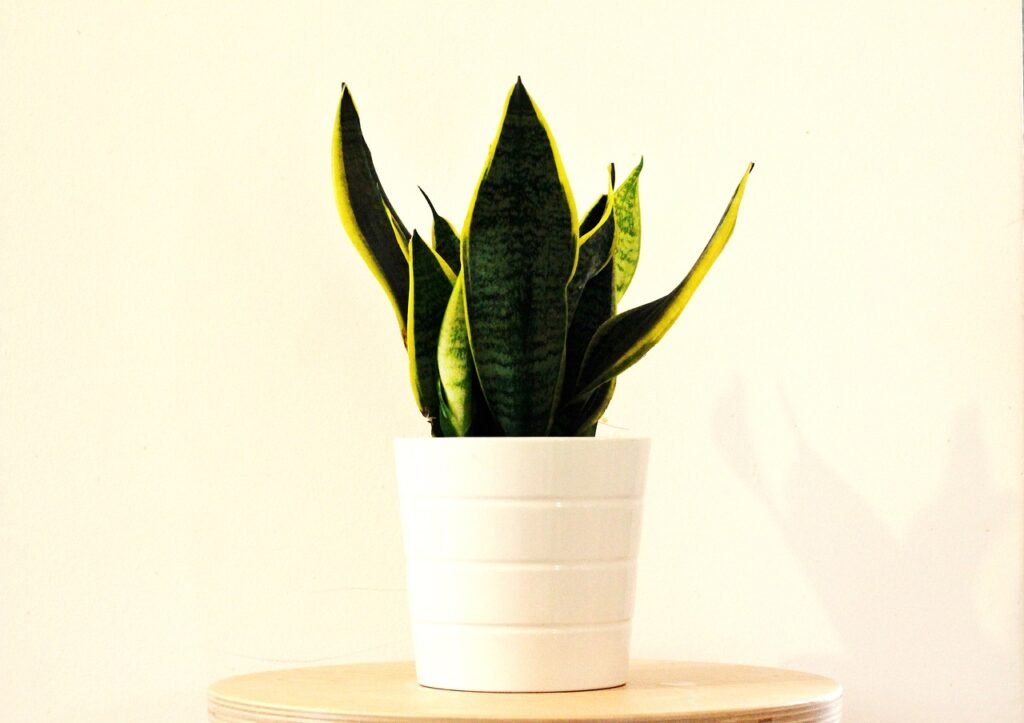
Snake plants offer many benefits, making them a great choice for indoor gardening. Check the key benefits given below:
- Air Purification: Snake plants filter harmful toxins like formaldehyde and benzene. It improves air quality. They rank high for removing indoor pollutants, as noted in a NASA study.
- Oxygen Production: Snake plants make oxygen at night, which helps you breathe better. This can help you sleep well and stay healthy.
- Low Maintenance: These plants are easy to take care of. They can grow in low light and only need a little water now and then. This makes them perfect for busy people.
- Allergen Reduction: Snake plants add moisture to the air. It helps reduce dust and allergens, making it easier for people with allergies to breathe.
- Aesthetic Appeal: Snake plants look nice with their tall, green leaves & cool patterns. They can make any room or office more beautiful.
- Mental Health Benefits: Snake plants can help reduce stress and make you feel happier. This makes your space more enjoyable.
Snake Plant as a Feng Shui Element
Snake plants play a special role in Feng Shui, enhancing both energy and aesthetics in your home. These plants symbolize protection and resilience, absorbing negative energy and promoting positivity. Their upright, sword-like leaves represent strength and stability, ideal for boosting energy.
In Feng Shui, the placement of a snake plant matters. Placing it in the career area can encourage ambition and assertiveness. Position it near the entrance to bring prosperity and good luck. Snake plants may not be ideal for relationship areas, as they represent defense.
The snake plant’s effect in Feng Shui depends on your energy and intentions. Thoughtful placement can create a balanced and harmonious living space.
Snake Plant for Different Spaces
Snake plants are versatile and you can place them in various indoor and outdoor spaces. Whether decorating a living room, bedroom, or outdoor garden, they provide health benefits. Below are some suggestions for where and how to use snake plants:
Best Spots for Snake Plant Indoors
Snake plants thrive in various indoor spaces. Place them in living rooms to add visual appeal and improve air quality. They also fit well in bedrooms, as they release oxygen at night, promoting better sleep.
In offices, snake plants boost productivity by purifying the air and reducing stress. They are also ideal for areas with less sunlight, like hallways or bathrooms.
Using Snake Plants in Outdoor Gardens
You can plant Sansevieria in outdoor gardens, especially in warmer climates. They thrive in shaded areas, adding structure to garden beds. Their drought-tolerant nature makes them perfect for xeriscaping.
Snake plants also enhance patios or balconies, where they create a modern look.
Planting in Pots vs. In the Ground
When planting snake plants, choose between pots or direct planting. Pots offer flexibility, allowing you to move plants indoors during colder months.
Additionally, potted snake plants need less water, making them easier to maintain. Direct planting in the ground works well in outdoor gardens.
In both settings, snake plants add beauty and resilience to any space.
Are Snake Plants Toxic To Pets?
When you have pets and snake plants (Sansevieria) at home, it is important to know they can be harmful if eaten. Snake plants have a substance called saponins that can upset your dog or cat’s stomach. If your pet eats part of the plant, it might vomit, have diarrhea, or feel sick. While it usually isn’t very dangerous, it can still make your pet feel uncomfortable.
Even though snake plants can be toxic, many people love them because they are easy to care for and clean the air. If you have pets, you can keep snake plants by putting them on high shelves or in rooms where your pets can’t reach them.
If your pet eats some of the plants, watch them for signs of being sick. With the right care, you can have snake plants and keep your pets safe at the same time.
Common Snake Plant Problems

Snake plants are usually easy to take care of, but they can have problems if not treated right. Here are some of the most common problems and their solutions:
Overwatering
Overwatering is the most frequent cause of problems in snake plants. When the soil stays too moist for too long, it can lead to root rot, yellowing leaves, and foul odors from the soil. To avoid giving them too much water, let the soil dry out completely before watering again. Make sure the pot has holes at the bottom so extra water can drain out.
Underwatering
On the flip side, allowing the soil to dry out for too long can also cause problems. Snake plants are drought-tolerant but still need occasional watering. Leaves may become limp, and brittle, or develop brown tips if the plant needs more water. Water your snake plant when the soil is completely dry, providing a thorough soak.
Pests
Snake plants can get pests like other houseplants. Some common pests are spider mites, mealybugs, scale insects, and thrips.
You can tell if your plant has pests by looking for things like tiny webs, white fluffy spots, and small bumps.
Leaf Problems
Yellowing, browning, or curling leaves can show a variety of issues. Yellow leaves are often a sign of overwatering or aging. Brown leaf tips or edges can mean underwatering, excess fertilizer, or cold damage. Curling leaves caused by thrips or low humidity. Prune off damaged leaves and adjust care.
Lack of Blooms
Some snake plant owners might feel a little disappointed if their plants don’t flower. Most types of snake plants bloom rarely, or sometimes not at all. To help your snake plant bloom, give it bright, indirect light, and let the soil dry out between watering.
If you take good care of your snake plant and avoid common problems, it can stay healthy and grow well for many years.
Debunking Snake Plant Myths
Despite their popularity, snake plants (Sansevieria) are subject to various myths and misconceptions. Let’s debunk some of the most common ones:
Myth: Snake Plants are Difficult to Care For
Fact: Snake plants are one of the easiest houseplants to maintain. They need minimal care, making them ideal for beginners and busy individuals.
Myth: Snake Plants Only Grow in Low Light
Fact: While snake plants can tolerate low light conditions, they prefer bright, indirect sunlight. Their growth is stunted if they receive improper lighting.
Myth: Snake Plants are Toxic to Humans
Fact: Snake plants are generally non-toxic to humans. However, they do contain saponins, which can cause mild discomfort if ingested. Keeping the plant out of reach of small children.
Myth: Snake Plants are Toxic to Pets
Fact: Snake plants are not toxic, however, can cause gastrointestinal issues in pets. Symptoms may include vomiting, diarrhea, and nausea. Pet owners should keep snake plants away from curious animals.
Wrap Up
The snake plant is a beautiful and easy-to-care-for houseplant that is good for your health. Whether you are great or starting a snake plants can make your home look nicer and help you feel better.
Snake plants can grow in different types of light and don’t need much water. This makes them perfect for busy people! They also clean the air by removing harmful chemicals like formaldehyde and benzene. Plus, they give off oxygen at night, which can help you sleep better, so they are perfect for bedrooms.
In Feng Shui, snake plants bring good luck and strength. They are easy to care for but don’t give them too much water, and watch out for pests.
Snake plants are the best choice for any space, offering beauty and health benefits. Want to bring these benefits into your home? Visit the Plantzone store to find your perfect snake plant today!
FAQs
Can snake plants grow in water?
Yes, snake plants can grow in water. They thrive in hydroponics if the water stays clean and receives enough sunlight. To grow them in water, place cuttings in a clear container, keeping leaves above the waterline. Change the water every 5-7 days to ensure good quality.
Why is my snake plant turning yellow?
Yellow leaves usually mean overwatering, which leads to root rot. Allow the soil to dry completely before watering again. Other causes include low light or lack of nutrients. If yellowing continues, review and adjust the care routine.
Why are my snake plant leaves splitting?
Leaves split because of uneven watering or rapid growth. Drought followed by heavy watering may cause sudden moisture intake, splitting leaves. Keep a consistent watering schedule and ensure proper humidity to avoid this.
Can snake plants grow from a leaf?
Yes, you can propagate snake plants from leaf cuttings. Cut a healthy leaf into sections, and let the cut ends dry for two days before planting in water or soil. With the right care, roots develop, and new plants grow.
How many types of snake plants are there?
There are many snake plant varieties. Popular types include Sansevieria trifasciata, Sansevieria cylindrica, Sansevieria laurentii, Sansevieria ‘Moonshine’, and Sansevieria ‘Hahnii’. The variety of sizes, shapes, and colors makes them perfect for indoor gardening.




